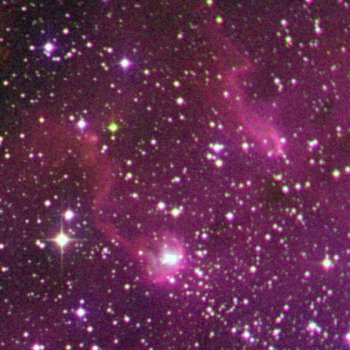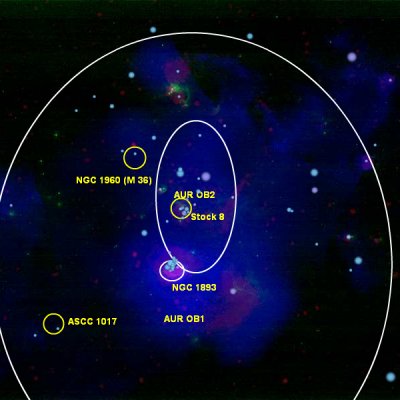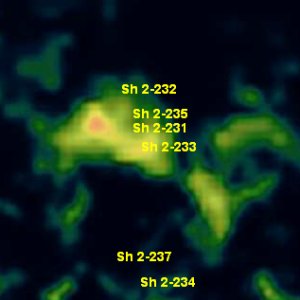
The famous tadpole pennant nebulae provide the name for this sector.
Source: DSS2 - see the information at the bottom right here for more information on the source of this image.
The Tadpole nebula (Sh 2-236, IC 410, W8), so called because of the presence of the tadpole-shaped pennant nebulae Sim 129 and Sim 130 [1], lies at the edge of the Aur OB2 association in the outer galaxy. The Tadpole nebula is ionised by the young star cluster NGC 1893, which contains five catalogued O-class stars [2], including HD 242926 (O6) and HD 242935 (O7 V)[ISC]. Distance estimates to the Tadpole nebula vary widely from 3200 to over 6000 parsecs.
Positioned in front of this region is the much closer Aur OB1 association at about 1300 parsecs (according to Humphreys), which includes at least 6 O-class stars. H. M Tovmasyan and his colleagues, using the Glazar space telescope on board the Russian Mir space station, concluded that Aur OB1 is in fact two different associations, one at 1100 pc and the second at about 2000 pc. [3] This does seem to better represent the distance estimates for HII regions and molecular clouds in this sector and implies that the Aur OB1 associations and their related molecular clouds form the outer boundary of the Orion Spur in this sector, much as the Gemini clouds do further east. A recent analysis also suggests that Aur OB2 should be subdivided with a near association at about 3000 parsecs and far association at about 6000 parsecs in the Outer arm. [4]
The 41.6 million year old star cluster Messier 36 (NGC 1960) appears to be part of the Aur OB1 association at a distance of 1318 parsecs. It contains the ionising stars DM +34 1111 (B2V) and DM +34 1113 (B2Ve). The younger (13.1 million years) and recently discovered cluster ASCC 1017 appears to be part of the more distant region of Aur OB1 at about 2000 parsecs. It contains the ionising star HD 35215 (B1 V).
At about 2300 parsecs is the Spider (IC 417, Sh 2-234) nebula and at 1800 parsecs is the Fly (Sh 2-237) nebula. A spectacular image of the Spider and Fly together can be found here. The Spider nebula appears to be ionised by the star cluster Stock 8, which contains the O-class star TYC 2411-866-1 (O 8). The Fly nebula surrounds the ten-million-year-old star cluster NGC 1931. [5]

The major ionising stars, clusters and associations for this sector.
Source: Galactic Plane Explorer composite image
Far in front is the Flaming Star nebula (Sh 2-229), at 510 parsecs. The Flaming Star nebula surrounds the runaway O9.5Ve star AE Aurigae, which is believed to have been knocked out of Orion's Trapezium cluster by an interstellar collision about 2.5 million years ago. [6]
The Flaming Star, Tadpole, Spider and Fly nebulae all seem surrounded by the enormous diffuse HII region Sh 2-230. Both Sharpless [7] and V.S. Avedisova [8] suggest that Sh 2-230 is associated with the Aur OB1 association. Avedisova identifies 3 ionising stars for Sh 2-230 - HD 35633 (B0.5IV), HD 35653 (B0.5V) and HD 36212 (B3II). Sharpless instead associates the first two of these stars with the Spider nebula, although this is not contradictory as these stars may help to ionise both nebulae. A distance estimate of 3200 parsecs for Sh 2-230 has been given based on a presumed association with infrared source IRAS 05197+3355 [9], [10]. However, this estimate implies that Sh 2-230 has a diameter of about 280 parsecs and may be too large.
To the north is the huge molecular cloud complex at 1800 parsecs associated with Sh 2-231, the peculiar belted Sh 2-232, the high mass star formation region Sh 2-233, and the kidney-shaped Sh 2-235. A good image of this region can be seen here. At least one paper [11] suggests that the Fly nebula may also be related to this complex as it is at a similar distance. The two largest colliding molecular clouds in this region consist of 100 thousand and 300 thousand solar masses of gas and dust respectively and are causing intense star formation near and within Sh 2-235 [12]. The molecular cloud complex is most visible at microwave (CO) frequencies, and is densest around Sh 2-235, but the nebulae can be seen at the other frequencies as well.
&

Massive colliding molecular clouds dominate the region around the kidney-shaped Sh 2-235.
Source: Galactic Plane Explorer microwave image
The large bubble at the far east (most visible in hydrogen-alpha) is the 30-40 thousand year-old supernova remnant SNR 180.0-01.7 (Sim 147, Sh 2-240) which contains the 143 ms pulsar PSR J0538+2817 [13]. A good image of Sim 147 can be seen here. The usual distance estimate for Sim 147 is 800 parsecs [14], although a recent paper estimates the distance as between 1200-1890 parsecs [15].
North of Sim 147 is another supernova remnant, SNR 179.0+02.6. This object is clearly visible in radio images, but little appears on it in the scientific literature. Green's comment on the radio image is "Thick shell, with background extragalactic sources near centre".
Just below the galactic plane at 177.7° longitude is CPM 18, a young stellar object surrounded by nebulosity and visible in infrared.
Nebulae in this sector
Notes
1. ^ Marco, Amparo, Bernabeu, Guillermo, & Negueruela, Ignacio 2001, Astronomical Journal, Photometric and Spectroscopic Study of the Young Open Cluster NGC 1893
2. ^ Negueruela, I., Marco, A., Israel, G. L., & Bernabeu, G. 2007, Astronomy and Astrophysics, Pre-main-sequence stars in the young open cluster NGC 1893. II. Evidence for triggered massive star formation
3. ^ Tovmasyan, H. M., Ovanesyan, R. Kh., Epremyan, R. A., Huguenin, D., & Tovmasyan, H. M. 1994, Monthly Notices of the Royal Astronomical Society, The distribution of OB stars in the directions of the stellar associations AUR OB 1 and 2
4. ^ Negueruela, I. & Marco, A. 2003, Astronomy and Astrophysics, Stellar tracers of the Cygnus Arm. I. Spectroscopic study of bright photometric candidates
5. ^ Bhatt, B. C., Pandey, A. K., Mahra, H. S., & Paliwal, D. C. 1994, Bulletin of the Astronomical Society of India, CCD photometry of galactic open star clusters-III. NGC 1931
6. ^ Hoogerwerf, R., de Bruijne, J. H. J., & de Zeeuw, P. T. 2000, Astrophysical Journal, The Origin of Runaway Stars
7. ^ Sharpless, Stewart 1959, Astrophysical Journal Supplement Series, A Catalogue of H II Regions.
8. ^ Avedisova, V. S. & Kondratenko, G. I. 1984, Nauchnye Informatsii, Exciting stars and the distances of the diffuse nebulae
9. ^ Snell, Ronald L., Dickman, Robert L., & Huang, Y.-L. 1990, Astrophysical Journal, Molecular outflows associated with a flux-limited sample of bright far-infrared sources
10. ^ Pirogov, L. 1999, Astronomy and Astrophysics, J=1-0 HCN toward bright far-infrared sources in the outer Galaxy
11. ^ Moffat, A. F. J., Jackson, P. D., & Fitzgerald, M. P. 1979, Astronomy and Astrophysics Supplement Series, The rotation and structure of the galaxy beyond the solar circle. I - Photometry and spectroscopy of 276 stars in 45 H II regions and other young stellar groups toward the galactic anticentre
12. ^ Lafon, G., Baudry, A., de La Noe, J., & Deharveng, L. 1983, Astronomy and Astrophysics, The molecular cloud-H II region complexes associated with SH 90 and SH 235
13. ^ Kramer, M., Lyne, A. G., Hobbs, G., Löhmer, O., Carr, P., Jordan, C., & Wolszczan, A. 2003, Astrophysical Journal, The Proper Motion, Age, and Initial Spin Period of PSR J0538+2817 in S147
14. ^ Blitz, L., Fich, M., & Stark, A. A. 1982, Astrophysical Journal Supplement Series, Catalog of CO radial velocities toward galactic H II regions
15. ^ Ng, C.-Y., Romani, Roger W., Brisken, Walter F., Chatterjee, Shami, & Kramer, Michael 2007, Astrophysical Journal, The Origin and Motion of PSR J0538+2817 in S147










